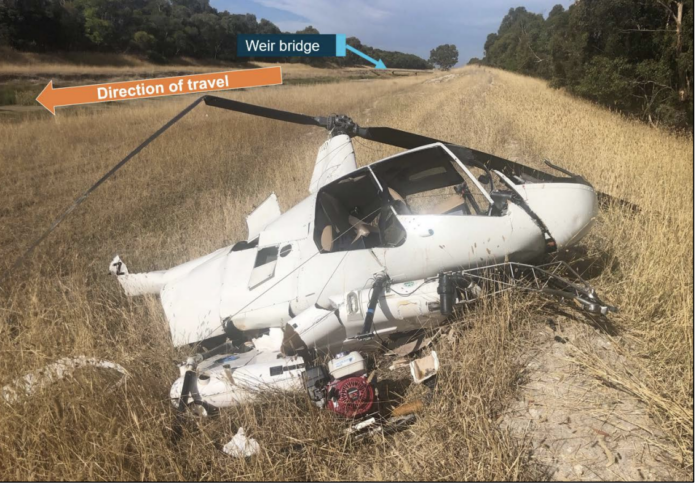A Robinson R44 helicopter striking a powerline while conducting aerial spraying provides another example of the dangers posed by powerlines during low-level operations, an ATSB investigation has highlighted.
The pilot then started a spray run from the eastern end of the drainage channel, and flew west towards a weir bridge and the powerline, which the pilot was aware of the presence of. Just before the bridge, the pilot noticed the helicopter was slightly lower than intended to provide adequate clearance over the bridge. The pilot positioned the helicopter to pass over the bridge and then under the powerline.
The ATSB found the pilot lost awareness of the position of the powerline as he manoeuvred over the bridge, and nearby vegetation likely reduced the ability of the pilot to regain that awareness.
This accident provides another reminder of the dangers posed by powerlines during low-level spraying operations.
The powerline struck the centre of the helicopter’s front section just above its headlights and cut into the helicopter cabin and control instruments. The helicopter landed hard on the bank of the drain and was destroyed. The pilot escaped with minor injuries, and there was no post-impact fire. The helicopter had been fitted with a bladder-type fuel tank, and there was no indication of a fuel leak. The bladder-type fuel tank probably reduced the likelihood of a fuel leak and post-impact fire following the collision.
“This accident provides another reminder of the dangers posed by powerlines during low-level spraying operations,” said ATSB Director Transport Safety Dr Stuart Godley.
“As this accident highlights, there may be limits to the extent to which operators can mitigate the risk of wirestrike during repeated low-level operations near powerlines.”
The ATSB points pilots and operators to a booklet jointly produced with the Aerial Application Association of Australia (AAAA), Wirestrikes involving known wires: A manageable aerial agriculture hazard, which contains numerous lessons learnt from wirestrike accidents for pilots and operators. The AAAA’s have also recently launched their Powerline Safety Program which promotes the marking of powerlines by powerline network operators wherever it is requested by a pilot, aviation company or landholder.
“Pilots and operators involved in low-level aerial spraying are also reminded that flight helmets are vital to reducing the risk of injury in the event of an accident,” Dr Godley said.
Read the report AO-2019-011: Wirestrike and collision with terrain involving a Robinson R44, VH-ZWK, near Naracoorte, South Australia on 13 March 2019





